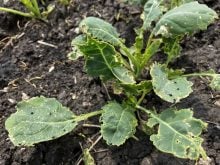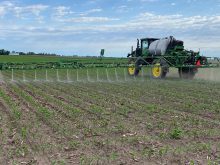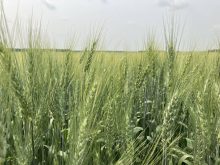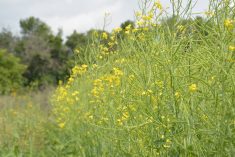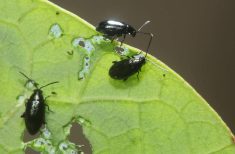EDMONTON — Plant less, grow more and put the profits in farmers’ jeans.
Research points to improved returns for farmers who reduce canola seeding rates, to a point. And many have, but only partially for the right reasons.
The long-term canola plant stand target has been seven to 10 plants per sq. foot, and the Canola Council of Canada continues to recommend it, even though seed prices have risen relative to canola price over the years.
However, like seed price, yield has also grown.
Murray Hartman of Alberta Agriculture feels that farmers should be basing their decisions to reduce or increase seeding rates based on productivity and margins rather than just the price of seed.
Read Also

Growing garlic by the thousands in Manitoba
Grower holds a planting party day every fall as a crowd gathers to help put 28,000 plants, and sometimes more, into theground
“I’ll bet 80 percent of growers couldn’t tell me what their average canola emergence was last year, or in any year,” he said last week at Farm Tech in Edmonton.
Emergence is key to plant stands, but what might not be well understood is how each farm is doing on emergence.
Seed beds vary significantly, while the age, design and wear of equipment also play into the number. As well, agronomy practices and soil type can significantly produce larger and smaller plant counts.
Despite standard recommendations, a recent prairie weed survey found that producers seed four to six plants per sq. foot, and they are likely doing it by cutting seeding rates.
“I think it is largely due to producers making decisions (on seeding rates) by saying I will only pay $X for seed per acre and seeding accordingly,” he said.
“It’s time to rethink the target.”
A crop with two plants per sq. foot will perform as well as one with 10 in the right years, but the risk that a crop with two plants per sq. foot will underperform are significantly more expensive than the cost of seed.
Pooled data on the herbicide tolerant hybrids is showing that farmers’ risks of not growing a good crop start to climb significantly as the plant population drops below four plants.
“Weather becomes a bigger factor. Insects and other pests too,” Hartman said about smaller plant stands.
Canola’s plasticity means that it can build a good crop based on a few plants, but later-developing canopies often require additional herbicide applications, which potentially adds risks for weed selection for herbicide tolerance.
“So every farmer needs to make a choice based on their own fields and experience,” he said.
There was a time when it would be difficult to over-spend on canola seed, but lower returns per acre and rising seed prices have narrowed return on investment.
Yields, while increasing well over the past decade, have somewhat plateaued for many growers, where moisture or growing season are limited.
“You can’t pay off the seed above about six to six and half pounds,” said Hartman.
“Is the extra seed worth an extra spraying pass? In some cases it is. Sometimes the spraying might be more economically feasible.”
Earlier maturity from higher plant counts can be an issue for producers who seed later or in short-season areas. In those cases, higher seeding rates and the resulting populations become an economic factor.
“Four to six plants adds a day (over seven to 10). Two might add a week and increase the risk of green seed,” Hartman said.
“Do you need more stubble to hold onto the crop in those high-wind prone areas? If you can save two pounds (of seed), that might mean $24 (per acre). It might be worth it.”





